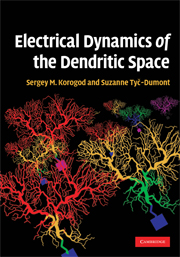Book contents
- Frontmatter
- Contents
- Preface
- 1 Definition of the neuron
- 2 3D geometry of dendritic arborizations
- 3 Basics in bioelectricity
- 4 Cable theory and dendrites
- 5 Voltage transfer over dendrites
- 6 Current transfer over dendrites
- 7 Electrical structure of an artificial dendritic path
- 8 Electrical structure of a bifurcation
- 9 Geography of the dendritic space
- 10 Electrical structures of biological dendrites
- 11 Electrical structure of the whole arborization
- 12 Electrical structures in 3D dendritic space
- 13 Dendritic space as a coder of the temporal output patterns
- 14 Concluding remarks
- Index
- References
14 - Concluding remarks
Published online by Cambridge University Press: 03 May 2010
- Frontmatter
- Contents
- Preface
- 1 Definition of the neuron
- 2 3D geometry of dendritic arborizations
- 3 Basics in bioelectricity
- 4 Cable theory and dendrites
- 5 Voltage transfer over dendrites
- 6 Current transfer over dendrites
- 7 Electrical structure of an artificial dendritic path
- 8 Electrical structure of a bifurcation
- 9 Geography of the dendritic space
- 10 Electrical structures of biological dendrites
- 11 Electrical structure of the whole arborization
- 12 Electrical structures in 3D dendritic space
- 13 Dendritic space as a coder of the temporal output patterns
- 14 Concluding remarks
- Index
- References
Summary
Coming back from our journey into dendritic space, we bring back with us the conviction that we have discovered some new critical notions which are the messages that we must pass on.
What did we learn about the features pictured in many handbooks under such key words as branching dendrites, complex trees, tapering branches, branching point, excitable dendrites, etc. These words give a feeling of déjávu. Do they really take on a special new significance in the description of operating neuronal dendrites as dynamical electrical devices? We strongly believe that the answer is yes indeed, as we attribute a specific role to every one of these structural features in a harmonious working ensemble!
The scope of our book is restricted to the dynamical electrical picture of dendritic space. This picture is composed of spatial profiles of electrical values along dendritic branches. We refer to what is observed as electrical states of parts of the whole dendritic arborization. Mapping these values on the reconstructed images of the dendrites provides a specific mosaic of electrical states of its parts, characterizing the electrical state of the whole arborization. The dendritic structure is both the bearer and determinant of its electrical properties as a whole.
To make these geometric features and the mechanisms underlying their function clearer, we select special artificial conditions which help to unveil some hidden neuronal operations. We use models imperfect and simplified, but efficient to analyze reality. They replace impossible observations by simulations.
- Type
- Chapter
- Information
- Electrical Dynamics of the Dendritic Space , pp. 197 - 204Publisher: Cambridge University PressPrint publication year: 2009



